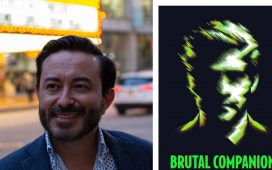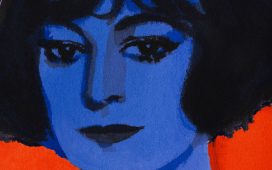According to the script, the title of the latest play by Dominique Morisseau is “Bad Creole Kreyòl.” We go with the simplified “Bad Kreyòl”—the language of Haiti written in its language, rather than its gallicization—because how can you bring voice to the strike-through, a gesture that underscores the voyeur state of the reader, “watching” the writer work it all out right there on the page? That’s what Morisseau’s surprising new play is about: the revision of those master stories we have been told, and that we tell ourselves, about where we come from. The forty-six-year-old playwright has never been so meditative on the possibilities of language, the vessel for story, as she evidently is with this new work. In the twenty-tens, Morisseau, who was born and raised in Detroit, made herself a griot-like figure for her home town with her Detroit trilogy, finding the human element in the grand narratives of social upheaval of the past hundred years: the gentrifying Black Bottom of the forties, the riots of the sixties, and the 2008 recession. Now Morisseau, who is half Haitian and half Black American, is exploring a new setting, that of urbane Port-au-Prince, some years after the 2010 earthquake, a natural disaster that brought to the fore, with devastating clarity, the unnatural cycles of exploitation that threaten to define Haiti. Is there a country in the Atlantic, besides the United States, so choked by mythologies?
Simone (Kelly McCreary) is a first-generation Haitian American—like Morisseau, she is half Haitian—who has come to the capital to visit the Haitian family she knows mostly in memory. Simone is a variation on the clueless Westerner: lugging her baggage across the stage, she thinks empathy is the way to social ingratiation. But, right away, her naked desire to understand, to make those around her smooth surfaces for knowing, sets the eye-rolling. Her cousin Gigi (Pascale Armand) greets Simone in English, as does Pita (Jude Tibeau), Gigi’s longtime confidant. We are seated in a theatre in New York City, mind you—English is the way. But Morisseau, and her director, Tiffany Nichole Greene, make sure that the spectre of translation and accommodation is prominent, by giving the characters accents. (All the players, except for McCreary, are Haitian or Haitian American.) Gigi speaks through an upturned mouth, casting judgment on anything and everything she finds subpar. “You probably couldn’t read his tone,” Gigi says to Simone, of a cab driver, Jeto, with whom Simone had no issues. “What you think is quiet and coöperative is really defiance and judgment.”
Simone is hampered by her poor grasp of Kreyòl. What else can’t she understand? The play is a jaspora diary—“jaspora” being the Kreyòl word for a member of the diaspora—and though the work seriously aims to give an arc of evolution to Pita and to Gigi, it is Simone, the jaspora, who goes through a kind of spiritual trial. She has not just gone to Haiti—in part to fulfill the dying wish of Grandmere, who wanted her two granddaughters to be in real friendship—she has been plunged into Gigi’s world. Gigi is the proprietor of the family shop, stocked with expensive bags and dresses she’s procured through international business connections, its walls adorned with incongruous revolutionary iconography. The stage design leaves no detail to be imagined, lest we fill our minds with prefab images of Haitian destitution. Gigi, who wears A-line skirts and strappy, coral sandals, is the picture of upper-class island cosmopolitanism. Simone, with her tin ear for caste, doesn’t understand Gigi’s station. Simone’s gaffes make for good comedy: when she unwittingly denigrates Gigi’s shop, calling it a “beach boutique,” Gigi spits back, insulted, “a beach bouuuuutique.” Gigi is a snob, but she is an appealing one. Her pride lives right next to her woundedness.
“Bad Kreyòl” opened at the Signature Theatre, in midtown, on October 28th. A few days before the opening, I met with Morisseau at the Signature, in a library used by the theatre company’s resident writers. I wanted to know more about why she literally and metaphorically left the States with her new comedy of manners. I share jaspora identity with her but on a different gradient, having been raised by two Haitian parents in Brooklyn not too far from Little Haiti.
Morisseau had just flown in from Detroit, where she was working on a film, along with her husband and her child. At the Signature, her husband, a musician and d.j., sometimes spins before the show, pulling classic Kompa joints and newer Haitian drill. (Morisseau mimed reactions from Haitian audience members: “ ‘I can’t believe I’m hearing Kreyòl on Forty-second Street.’ ”) Some of the family history in the play is drawn from Morisseau’s life. But after meeting Morisseau, I realized that Simone, the confused altruist, disillusioned with her finance degree, is not a pure stand-in for the playwright. On a trip to Haiti in 2014, many years after her previous visit, Morisseau was joined by her father, who had immigrated to the U.S. as a young child. She recalled driving around Port-au-Prince. “I remember we had a driver, and I’m, like, ‘What are the rules?’ These cars have rules. Only they know, but they know them.” She continued, “I didn’t get into an accident, but I don’t understand how an accident is not happening.”
What is known but unspoken is one of the main subjects of “Bad Kreyòl.” Gigi and Simone clash in part because their strategies for survival don’t mix. Morisseau understands our clinging to aphoristic self-explication. Simone believes in living out loud, in “affinity” spaces. Gigi lives not in fear, per se—the pedigree of her family keeps her and everyone associated with her safe in the city—but she is a realist. She comments on Simone’s hair, which is natural and unprocessed, unlike her own, which flows like water, because Gigi, behind the times, sees curly hair as a problem to be fixed. Pita loves Simone’s look; he’s ekléré, as you’d say in Kreyòl, enlightened, or in the know. He rolls his hips, punctuates sentences with a “n’est-ce pas,” or “cherie.” There’s a friendship triangle taking shape, as Simone and Pita grow closer, shutting Gigi out. Pita confides in Simone that he is queer, and she encourages him to join the local gay-rights group, called Kouraj. Who is Pita—to Simone, to Gigi? Is he “cousin,” as he says? Pita had come to live with the family, when he was a child, as a “restavek,” a servant. To Simone, child servitude is an evil so plain even CNN can condemn it. To Gigi, the beneficiary, Pita was treated well, and, anyway, isn’t the American foster system a comparable social ill? For Pita, living in the city saved his life. He’d have been doomed, he imagines, back home in the country, to become a dictator’s henchman. There seems to be a ventriloquism in these conversations, which are expository and lecture-like. Morisseau is capturing how people talk about themselves, always wanting to define themselves first, before someone else does so, violently, on their behalf.
Simone, the wrecking agent, causes tenuous systems to spin out of whack, with the events coming close to, but never approaching, real tragedy. Morisseau is not sanitizing so much as she is heeding the earthy conventions of genre, allowing melodrama to dictate where she will and will not go. There is a turntable set that revolves around Gigi’s boutique: it serves as a nighttime façade; a warehouse where Gigi meets Thomas (Andy Lucien), a middleman who brokers deals with Gigi and her “international” clients; and as the workroom at Fi Travay, an N.G.O. “Those poor helpless Haitians with incompetent government who would perish without their interference,” Pita says, pantomiming the colonizer’s stance. At Fi Travay, Simone meets Lovelie (Fedna Jacquet), a seamstress. The organization employs former sex workers to do artisan work and takes a big cut from their profits. Lovelie admits to Simone that one of the partners at the organization sexually abuses her. Horrified, Simone tries to intervene on her behalf. Intervention, though, would put Lovelie in economic peril. The cold, Gucci-belt pragmatism of Thomas is the play’s existential refrain. “I think you will find that exploitation is necessaire,” he says. “If not us to do so, then it will be us it is done to.”
Simone has a moment of revelation, listening to her own plea for ancestral communion. It’s a moment that is played for laughs. “Oh, God,” she says. “I just made magical negroes of the Haitians.” It is the exhaust pipe being let out, the cycle stopping its spin. I enjoyed “Bad Kreyòl,” but the play has a divided soul. It is so aware of the discursive field it enters, aware of the stereotypes walking into the room, along with the audience as they take their seats. Morisseau is not doing simple subversions, as she is always, at the root, a world-maker, but the work does seem conscious of its own importance. It is conscious, too, of the aspect of exceptionalism that surrounds its subject—its grotesque uniqueness, to paraphrase the historian Colin Dayan, whether as a venerated democratic republic or a cursed, disappearing island. Before we enter the theatre, there is a time line on the wall, giving a social history of Haiti. Didacticism is not her thing, but Morisseau knows that the other is here, that the other is in all of us. When “Bad Kreyòl” rushes to its conclusion, one of casting down gripes and making amends, the audience I saw it with let out a sigh of relief, as if on cue.
The play will run through December 1st. I’ll tell everyone I know in the community to go. When Morisseau and I met, the first reviews had not been published yet. (They now have been, and they’re glowing.) She correctly anticipated that her play would be placed in a context of blooming anti-Haitian sentiment, as if she had sat down solemnly to write the corrective that would humanize the people in this season of slander. In fact, Morisseau had written a play against the American “invention” of Haiti, the cultural legacy of the States’ political occupation of the country in the early twentieth century.
Sometimes a character says something in Kreyòl before they say it in English. For example, Pita, providing his pithy perspective on labor and self-satisfaction: “Si travay te bon bagay, moun rich la pran-l lontan. . . . If were was a good thing, rich people would’ve grabbed it long ago.” In these bits, those in the know get to laugh first. ♦








